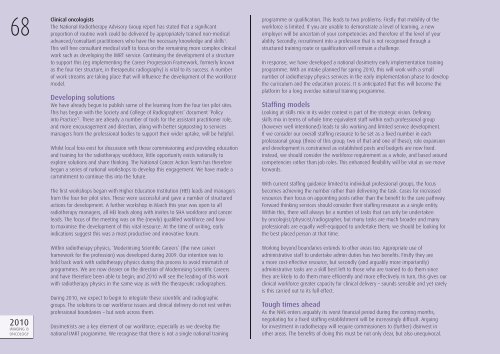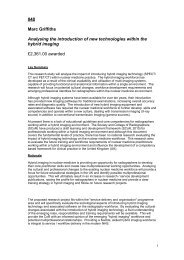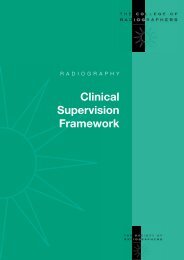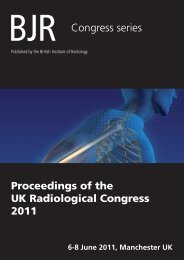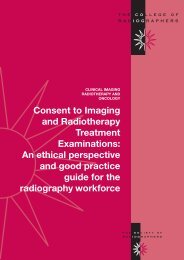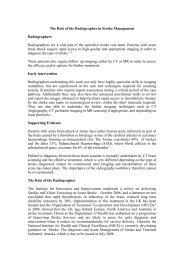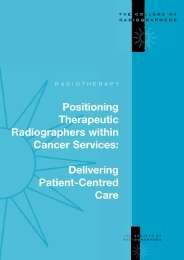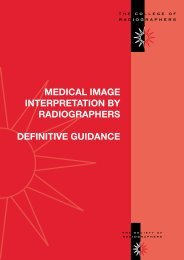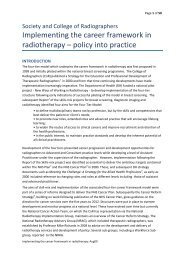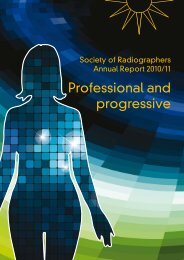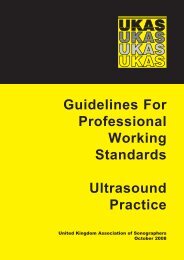IMAGING & ONCOLOGY - Society of Radiographers
IMAGING & ONCOLOGY - Society of Radiographers
IMAGING & ONCOLOGY - Society of Radiographers
- No tags were found...
You also want an ePaper? Increase the reach of your titles
YUMPU automatically turns print PDFs into web optimized ePapers that Google loves.
68Clinical oncologistsThe National Radiotherapy Advisory Group report has stated that a signifi cantproportion <strong>of</strong> routine work could be delivered by appropriately trained non-medicaladvanced/consultant practitioners who have the necessary knowledge and skills 1 .This will free consultant medical staff to focus on the remaining more complex clinicalwork such as developing the IMRT service. Continuing the development <strong>of</strong> a structureto support this (eg implementing the Career Progression Framework, formerly knownas the four tier structure, in therapeutic radiography) is vital to its success. A number<strong>of</strong> work streams are taking place that will infl uence the development <strong>of</strong> the workforcemodel.Developing solutionsWe have already begun to publish some <strong>of</strong> the learning from the four tier pilot sites.This has begun with the <strong>Society</strong> and College <strong>of</strong> <strong>Radiographers</strong>’ document ‘Policyinto Practice’ 2 . There are already a number <strong>of</strong> tools for the assistant practitioner role,and more encouragement and direction, along with better signposting to servicesmanagers from the pr<strong>of</strong>essional bodies to support their wider uptake, will be helpful.Whilst local fora exist for discussion with those commissioning and providing educationand training for the radiotherapy workforce, little opportunity exists nationally toexplore solutions and share thinking. The National Cancer Action Team has thereforebegun a series <strong>of</strong> national workshops to develop this engagement. We have made acommitment to continue this into the future.The fi rst workshops began with Higher Education Institution (HEI) leads and managersfrom the four tier pilot sites. These were successful and gave a number <strong>of</strong> structuredactions for development. A further workshop in March this year was open to allradiotherapy managers, all HEI leads along with invites to SHA workforce and cancerleads. The focus <strong>of</strong> the meeting was on the (newly) qualifi ed workforce and howto maximise the development <strong>of</strong> this vital resource. At the time <strong>of</strong> writing, earlyindications suggest this was a most productive and innovative forum.programme or qualifi cation. This leads to two problems: Firstly that mobility <strong>of</strong> theworkforce is limited. If you are unable to demonstrate a level <strong>of</strong> learning, a newemployer will be uncertain <strong>of</strong> your competencies and therefore <strong>of</strong> the level <strong>of</strong> yourability. Secondly, recruitment into a pr<strong>of</strong>ession that is not recognised through astructured training route or qualifi cation will remain a challenge.In response, we have developed a national dosimetry early implementation trainingprogramme. With an intake planned for spring 2010, this will work with a smallnumber <strong>of</strong> radiotherapy physics services in the early implementation phase to developthe curriculum and the education process. It is anticipated that this will become theplatform for a long overdue national training programme.Staffing modelsLooking at skills mix in its wider context is part <strong>of</strong> the strategic vision. Defi ningskills mix in terms <strong>of</strong> whole time equivalent staff within each pr<strong>of</strong>essional group(however well intentioned) leads to silo working and limited service development.If we consider our overall staffi ng resource to be set as a fi xed number in eachpr<strong>of</strong>essional group (three <strong>of</strong> this group, two <strong>of</strong> that and one <strong>of</strong> these); role expansionand development is constrained as established posts and budgets are now fi xed.Instead, we should consider the workforce requirement as a whole, and based aroundcompetencies rather than job roles. This enhanced fl exibility will be vital as we moveforwards.With current staffi ng guidance limited to individual pr<strong>of</strong>essional groups, the focusbecomes achieving the number rather than delivering the task. Cases for increasedresources then focus on appointing posts rather than the benefi t to the care pathway.Forward thinking services should consider their staffi ng resource as a single entity.Within this, there will always be a number <strong>of</strong> tasks that can only be undertakenby oncologist/physicist/radiographer, but many tasks are much broader and manypr<strong>of</strong>essionals are equally well-equipped to undertake them; we should be looking forthe best placed person at that time.2010<strong>IMAGING</strong> &<strong>ONCOLOGY</strong>Within radiotherapy physics, ‘Modernising Scientifi c Careers’ (the new careerframework for the pr<strong>of</strong>ession) was developed during 2009. Our intention was tohold back work with radiotherapy physics during this process to avoid mismatch <strong>of</strong>programmes. We are now clearer on the direction <strong>of</strong> Modernising Scientifi c Careersand have therefore been able to begin; and 2010 will see the leading <strong>of</strong> this workwith radiotherapy physics in the same way as with the therapeutic radiographers.During 2010, we expect to begin to integrate these scientifi c and radiographicgroups. The solutions to our workforce issues and clinical delivery do not rest withinpr<strong>of</strong>essional boundaries – but work across them.Dosimetrists are a key element <strong>of</strong> our workforce, especially as we develop thenational IMRT programme. We recognise that there is not a single national trainingWorking beyond boundaries extends to other areas too. Appropriate use <strong>of</strong>administrative staff to undertake admin duties has two benefi ts. Firstly they area more cost-effective resource, but secondly (and arguably more importantly)administrative tasks are a skill best left to those who are trained to do them sincethey are likely to do them more effi ciently and more effectively. In turn, this gives ourclinical workforce greater capacity for clinical delivery – sounds sensible and yet rarelyis this carried out to its full effect.Tough times aheadAs the NHS enters arguably its worst fi nancial period during the coming months,negotiating for a fi xed staffi ng establishment will be increasingly diffi cult. Arguingfor investment in radiotherapy will require commissioners to (further) disinvest inother areas. The benefi ts <strong>of</strong> doing this must be not only clear, but also unequivocal.


